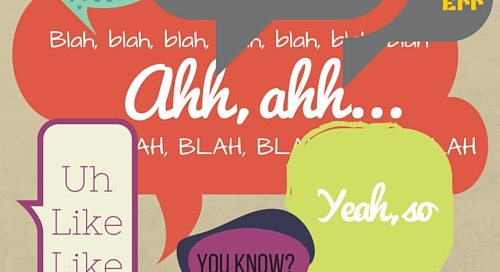Um, Err, Like, Yeah, You Know, Eh, Ugh, So, Well, OK, Actually…Filler words be gone!
What happens when you’re put on the spot and asked to say a few words with little, or no, preparation?
For some people that can be enough to cause an outbreak of the dreaded speech fillers.
Those ums and ahs are called disfluencies because they break the fluency or smooth flow of speech.
In a situation where you are the focus of everyone's attention, (a job interview, a sales pitch, a question-and-answer session…), disfluencies weaken what you have to say. Their presence lets your audience know you may be feeling:
anxious - you don't feel comfortable being looked at or having people expectantly waiting for what you have to say,
unsure - not completely confident about what you have to share, for any number of what could be, perfectly valid reasons,
or a mixture of both.
Regardless of the underlying cause, an excess of disfluencies or fillers undermines your message.
Let's do a test.
Try saying the sentence below aloud and really listen to yourself as you speak. Do you believe what you're saying?
(The bold words are the heart of the communication. The rest you can do without.)
"Yeah, well, um, I'd just like to say, um, like, you know, I think this is, um, a great opportunity and um, yeah, you know, like I can't wait to get started."
Diagnosing fillers
How do you know if you've got a bad case of fillers?
It's not the sort of thing many people will tell you about. Generally, it's considered rude, poor form, to comment on another person's habitual speech patterns. Nevertheless, that doesn't stop us from making judgments about them based purely on how they speak!
Here are two ways to find out whether you 'um and ahhh' for yourself.
1. Record yourself
Use the voice recorder on your phone to capture unrehearsed speech segments. The easiest way to do this is to ask yourself open-ended questions like:
What do I like about my present job?
Where would I like to be in five years’ time?
What's my favorite thing to do on a Sunday afternoon?
Listen to your answers and take note of the fillers.
2. Ask a friend or trusted colleague to count them for you.
Tell them you're on a mission to reduce the number of fillers you use in your everyday or unrehearsed speech and that you'd like them to note every instance they hear one over a specified time. Five or ten minutes should be enough.
This will give you a list of your habitual phrases or disfluencies, and the frequency of their use.
Your score might look like this:
"Like" - 5
"Um" - 6
"I dunno" - 3
"Well, actually" - 4
Cutting them out
Now that you know what you do, how do you STOP using fillers?
As you become more conscious of what you are actually saying, rather than what you think you are saying you will quite naturally start to substitute fillers for fluency.
A method I find useful is to pause. Take a breath. Give yourself a moment of silence to gather your thoughts before speaking.
To speed your progress give yourself regular conscious practice. Here's a bunch of impromptu public speaking topics to get you started.
Record yourself. Five minutes a day for a week will make a huge difference. Keep those recordings. To monitor your progress, after a couple of days replay the first few recordings you made and compare them to the most recent.
For more on structuring and presenting your thoughts well check these impromptu speaking templates. They're a collection of 7 very useful organizers.
For more on fillers
Andrew Dlugan's excellent evergreen 2009 post on Filler words in public speaking - Are… um… Filler Words… ah… Okay?. It attracted a lot of useful and interesting comments from public speakers.
A definition of filler words with examples from Thoughtco's grammar and composition expert Richard Nordquist.
Until next time,
Happy speaking,
Susan
PS. If you found this useful, feel free to share it and click the ❤️ button so more people can discover it on Substack. 🙏Thank you.




Spot on!!! Is my patience growing thinner?!? Or is there an epidemic of Filler Words?!?